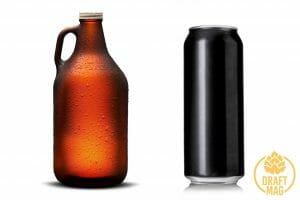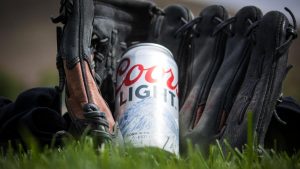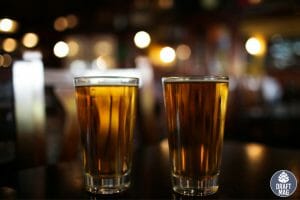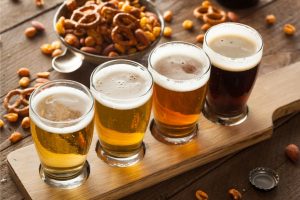Ginger Ale vs Ginger Beer: A Guide To Choosing Your Favorite Drink
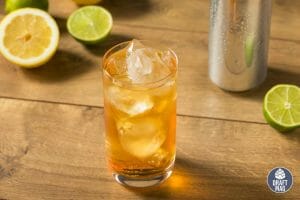 Leaving the Ginger Ale vs ginger beer debate aside, if you are someone with a palate for ginger, then carbonated ginger drinks are for you. It can get a bit confusing when you are looking to substitute ginger with either of these two drinks. However, this article will explain which ginger beverage to fill up your fridge with, depending on your taste, with the help of a fair comparison between the two. You will get a clear idea and make an informed decision, so let’s get to it!
Leaving the Ginger Ale vs ginger beer debate aside, if you are someone with a palate for ginger, then carbonated ginger drinks are for you. It can get a bit confusing when you are looking to substitute ginger with either of these two drinks. However, this article will explain which ginger beverage to fill up your fridge with, depending on your taste, with the help of a fair comparison between the two. You will get a clear idea and make an informed decision, so let’s get to it!
Quick Comparison Table
| Features | Ginger Ale | Ginger Beer |
| Flavor | Sweet, ginger-flavored | Stronger and spicier, ginger-flavored |
| Colour | Mostly clear | Clear or cloudy, depending on the level of fermentation |
| Aftertaste | Sweet and mildly gingery | Spicy |
| Alcohol content | 0 percent | Less than 0.5 percent |
| Carbonation | Heavily carbonated | Mildly carbonated |
What Are the Differences Between Ginger Ale and Ginger Beer?
The main difference between Ginger Ale and Ginger Beer is in their taste and the process used for their production; while ginger beer provides a stronger kick, ginger ale is a milder version. Both are carbonated ginger drinks, but the flavor profiles can be vastly different.
What Is Ginger Ale Best For?
Ginger Ale is best for those who are looking for a carbonated soft drink that has the flavor of ginger. Made from mainly ginger root and a sweetening agent, Ginger Ale is a mild ginger-flavored delicious carbonated beverage that is enjoyed across the world.
– Flavor
Ginger Ale is a mild ginger-flavored carbonated beverage. The taste is sweet with slight overtones of lime. However, the taste might differ depending on the brand.
Known for its refreshing quality, Ginger Ale can be a great palate cleanser and help wake you up instantly. The numerous healing properties of ginger can be experienced with this drink. Ginger is great in aiding digestion and also relieving migraine to an extent. This drink has been around for a long time and can be drunk on its own or added to other drinks.
– Food Pairings
Ginger Ale is a relatively sweet-tasting carbonated beverage that pairs well with foods with a high dosage of spices. The sweet drink cuts through the spices, providing a balanced meal. You can also pair Ginger Ale with foods that are seasoned well in any kind of cuisine.
– Types
Typical Ginger Ale is a regular type that can further be classified into two types. However, Ginger Ale can be broadly classified into three categories. These are:
- Regular Ginger Ale: The types of regular Ginger Ale are Ginger Ale soda and the traditional fermented Ginger Ale.
- Dry Ginger Ale: Dry Ginger Ale carries a spicier ginger flavor, thanks to the processing of the ginger root, which helps concentrate the flavor. As dried ginger is spicier, this Ginger Ale is spicier than the regular Ginger Ale beverage.
- Diet Ginger Ale: As the name suggests, diet Ginger Ale uses artificial sweeteners rather than traditionally used high fructose corn syrup and sugar. This makes the ginger drink a zero or low-calorie option to try out if you are worried about the calories.
– Nutrition Facts
A 100 grams bottle of Ginger Ale contains:
- Calories: 34
- Fat: 0 gram
- Cholesterol: 0 milligrams
- Sodium: 7 milligrams
- Potassium: 1 milligram
- Carbohydrate: 9 grams
- Protein: 0 gram
– How It’s Made
The main ingredients used in the production of Ginger Ale are ginger root, corn syrup, sugar, carbonated water, along with other flavoring agents, if any. Fermented water, ginger, or yeast are used to impart a fizzy feel and enhance the flavor. This carbonated beverage is free of alcohol and caffeine and can be enjoyed at all times.
The ginger flavor can be natural or artificial and varies from brand to brand. Alkaline compounds are added for preservation. Other additions to the Ginger Ale include preservatives like citric acid and sodium benzoate. Mainly clear in color, additional coloring agents can be added too.
There are two main steps in the Ginger Ale production process.
Fermentation
Traditionally fermented with ginger root, yeast, sugar, and other flavoring agents, Ginger Ale develops most of its flavor here. Conditions are made ideal for the ginger bug to propagate, kick-starting the fermentation process.
Ginger bugs are commonly found in old ginger skins and are often used as a replacement for yeast. Sugar is added to aid the fermentation process as ginger root is very low in sugar content. Ethanol and carbon dioxide are produced as a result, which remains intact in the containers that are designed to be air-tight.
Artificial Carbonation
Low-temperature water is added to the ingredients and allowed to carbonate the beverage. Low temperatures allow the dissolution of more carbon dioxide, which is then treated with sodium bicarbonate to counter the acidity. More carbon dioxide is added under pressure to finish off before storage and distribution.
– Uses
Here are some popular uses for Ginger Ale:
- Dry Ginger Ale is used as a soft drink.
- Ginger Ale is often used as a mixer for alcoholic and non-alcoholic beverages.
- It is beneficial for stomach upsets as ginger is an excellent ingredient for aiding digestion and has been used for centuries.
- Ginger Ale can be helpful in combating nausea.
– Popular Brands
Golden Ginger Ale labels that are well known are Vernors, Blenheim, reeds Ginger Ale real, Chelmsford, Buffalo Rock, Sussex, Bull’s Head, and Red Rock. Dry Ginger Ales that are popularly found are Canada Dry, Schweppes, and Seagram’s.
– History
The earliest known Ginger Ale is known to be produced in Genf by Jacob Schweppe in 1783. However, the first manufactured Ginger Ale was in the golden style, which was dark-colored, fermented, heavily spiced and with a sweet flavor, produced in Ireland by Thomas Joseph Cantrell, an apothecary and surgeon.
The local beverage company Grattan and Company took the task of marketing the Ginger Ale. The Ginger Ale started initially as a non-alcoholic carbonated variant of the famous Ginger beer invented in Yorkshire, England, in the Victorian age.
The modern age dry Ginger Ale was invented in 1907 by John McLaughlin, a Canadian pharmacist. The Ginger Ale was mixed with fruit juices and used to create sodas of different flavors, which was a huge crowd pleaser. The dry Ginger Ale was lighter in color and milder in taste. Thus, the Canada Dry Pale Dry Ginger Ale was born.
Club sodas now found a great substitute in the pale Ginger Ale, which was often found to mask the strong alcoholic spirit smell in the drinks. The dry style of Ginger Ale quickly became popular in the United States and Canada.
What Is Ginger Beer Best For?
Ginger beer is best for those who are looking for a mildly carbonated drink that has a stronger flavor of ginger than regular Ginger Ale. Since the alcohol content is relatively low, ginger beer is usually considered non-alcoholic. However, the level of alcohol may differ from one brand to another.
– Flavor
The present ginger beers found in markets have an aromatic flavor of ginger with a robust and spicy taste. The carbonation does impart a fizz, but the taste is pretty strong and gingery.
Originally brewed as an alcoholic beverage in Victorian England, Ginger beer was made by the fermentation of ginger, water, sugar, yeast, and cream of tartar. Sometimes, additional ingredients like citric acid, lemon juice, or lemon peel are added to help preserve the beverage better. The ginger beer alcohol content is regulated by bottling ginger beer before the completion of the fermentation process.
– Food Pairings
Foods that go well with ginger beer are seasoned, spicy, saucy foods, etc. The strong aroma of ginger makes everything taste better. Food items that are glazed with sauces can also be paired with this beverage. The best thing is that you can pair sweet as well as spicy foods, and all would taste great with ginger beer.
– Types
Broadly classified into two variants, ginger beer can either be alcoholic or non-alcoholic.
- Alcoholic ginger beer: Alcoholic ginger beer is the fermented version of the more popular commercial ginger beers available in the market. This type of ginger beer is brewed and the process differs from the non-alcoholic variants. The alcohol content usually depends on the process and duration of fermentation.
- Non-alcoholic ginger beer: Usually, non-alcoholic ginger beers are not fermented but carbonated with the help of carbon dioxide under pressure. However, some non-alcoholic ginger beers are brewed using the traditional process of brewing the ginger root with water, yeast, and sugar.
– Nutrition Facts
A can of 382 milliliters of ginger beer contains:
- Calories: 186
- Fat: 0 gram
- Cholesterol: 0 milligrams
- Sodium: 26 milligrams
- Potassium: 4 milligrams
- Total Carbohydrate: 48 grams
- Protein: 0 gram
- Dietary Fibre: 0 gram
– How It’s Made
Ginger beer recipe includes the fermentation of ginger root, water, sugar, and yeast. Usually cloudy in color, ginger beer is brewed by setting the fermentation in motion.
A GBP or Ginger Beer Plant is used, which is best explained as a colony of organisms that contain the yeast and bacteria driving the fermentation process. This yeast named Saccharomyces florentinus forms a symbiotic relationship with that of the bacteria, Lactobacillus hilgardii. This leads to the formation of a substance that is gelatinous in texture, traces of which can often be found on the surface of the beverage.
– Ingredients
Optional ingredients added to the drink include lemon juice, cream of tartar, etc. The fermentation process continues for a few days, producing alcohol. The GBP can be sourced commercially, often transferred from one batch to another, and can be reused for years. Sometimes, a ginger bug can be used as the starter for fermentation.
Simpler to form, a fermented mixture of water, yeast, ginger, and sugar can be made to develop the bug. The more sugar added, the more the alcohol content produced. Once the process is complete, the beverage is strained and diluted with water and sometimes lemon juice. The beverage is then bottled, completing the manufacturing process.
The ginger beer from the two different fermentation processes usually differs a lot in flavor. While GBP is preferred more for homemade variants, commercially produced ginger beers usually use Brewer’s yeast for the process. This is due to the easier method of production and the more commercial availability of Brewer’s yeast.
– Uses
There are numerous uses for Ginger beer which makes it a popular choice of beverage all over the world.
- Ginger beer works great as a digestion enhancer.
- Ginger beer is a popular beverage to try when you are feeling nauseated.
- Ginger root has been used for a very long time as an ingredient to curb inflammation in body parts. Ginger beer, therefore, can help reduce inflammation to an extent.
- Ginger beer helps add a spicy flavor to many cocktails. A few famous ginger beer cocktails are Moscow Mule and the Dark and Stormy.
- Ginger beer can be used at home to flavor liquors and pairs great with almost any liquor.
– Popular Brands
Fever-Tree, Goslings, Q Ginger Beer, Zevia Ginger Beer, Reed’s Ginger Beer Zero Sugar, Reed’s Extra ginger Beer, Bundaberg diet Ginger Beer, Brooklyn crafted ginger beer and Old Jamaica Ginger Beer are some of the best-known ginger beer brands available in the market.
– History
Ginger has been in use since times immemorial as a medicine and a potent flavoring agent for dishes. In countries with ancient cultures like India and China, ginger has been in use as a vital ingredient in almost all main food dishes. Similarly, in the western half of the world, ginger was made to flavor drinks and added a little spice to them.
Ginger beer originated as an alcoholic beverage in England’s Yorkshire in the Victorian period. This drink quickly became popular with the masses and crossed continents to reach the United States, South Africa, and Canada. England’s neighboring country, Ireland, is the proud inventor of the milder soft drink variant of ginger beer, the Ginger Ale.
The popularity of ginger beer peaked in the early part of the 20th century. To this day, ginger beer remains a vastly enjoyed and popular drink used in making some great cocktails.
Conclusion
Concluding the debate of Ginger Ale vs ginger beer, it is best to say that if you are an admirer of ginger flavor, you must try out both. However, if you are looking for something to spice up your drinks and add that depth of ginger, ginger beer will be a better option.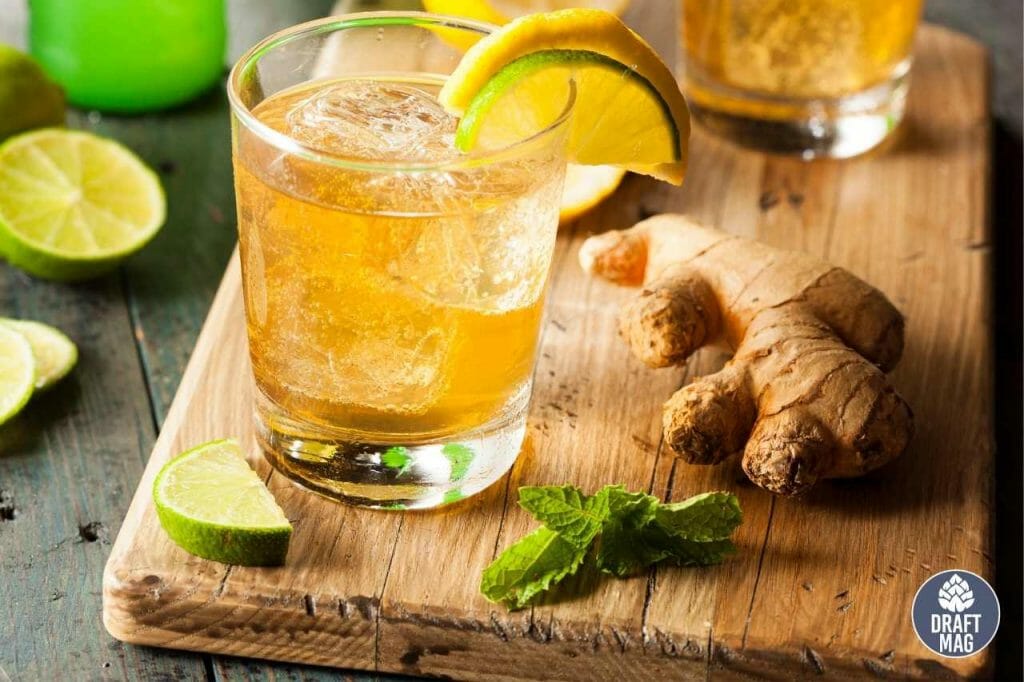
Both Ginger Ale and ginger beer have a plethora of health benefits as ginger is the primary ingredient. No matter which ginger-flavored beverage you choose, you are bound to reap the benefits.



